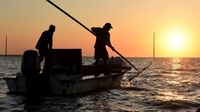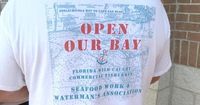After five long years of silence, the sound of oyster tongs scraping the bottom of Apalachicola Bay may soon return. Florida wildlife officials have taken a decisive step toward reopening the once-prolific bay for oyster harvesting, a move many locals see as a lifeline to both the region’s economy and its identity. The Florida Fish and Wildlife Conservation Commission (FWC) approved a proposal on August 14, 2025, to allow limited oyster harvesting beginning January 1, 2026, after a closure that began in 2020 due to the catastrophic collapse of local oyster populations.
For generations, Apalachicola Bay stood as the beating heart of Florida’s oyster industry, supplying a staggering 90% of the state’s oysters and 10% of the national market, according to the Tampa Bay Times. But the tides turned dramatically over the past two decades. In the early 2000s, the bay boasted 10,000 acres of healthy oyster habitats. By 2013, the industry had collapsed, and by the time the state shuttered the fishery in 2020, only about 500 acres remained suitable for oysters—and fewer than 100 acres were producing enough for commercial harvest, WJHG/WECP reported. Drought, increased upstream water consumption in metro Atlanta, agricultural runoff, predation, and overharvesting all contributed to the devastation.
“It’s part of who we are,” said Ricky Jones, chair of the Franklin County Board of Commissioners, expressing hope that the reopening would help breathe life back into the community. “Tomorrow would be a good day,” he remarked, though he acknowledged the process would not be instantaneous (WMBB).
The proposed reopening is cautious and measured, reflecting both the fragility of the ecosystem and the lessons learned from the past. The FWC’s plan will initially allow harvesting on just 100 acres of the bay, specifically targeting four reefs: Cat Point NWFWF, Cat Point Spur, Easthole, and Peanut Ridge. These areas met a strict threshold—each must support a minimum of 400 bags of legal-sized oysters per acre, a standard set by the Florida Department of Agriculture’s Standard Oyster Resource Management Protocol. Both commercial and recreational harvests will be permitted, but only in these designated areas and under tight restrictions.
The initial season will run from January 1 through February 28, 2026. Afterward, officials will reassess the health of the reefs, with the possibility of reopening the bay for a longer season from October 2026 through February 2027. “They took a step forward to reopen the fishery in a limited fashion using a conservative approach that their staff had put together, which means allowing some harvest but on certain areas that have more oysters than others,” explained Chad Hanson, science and policy officer with The Pew Charitable Trusts and a former FWC marine biologist (WJHG/WECP).
Regulations will be strict. Commercial harvesters must hold an individual or crew Saltwater Products License, a Shellfish (BV) Endorsement, be Florida residents, and—at least for the first year—show proof of wild harvest oyster landings from Apalachicola Bay between 2012 and 2020. Catch limits will be set at 10 unattached oysters and 30 attached oysters per bag. Statewide, new rules will prohibit possession of unculled oysters and reduce tolerances for undersized oysters, all in an effort to minimize reef loss and promote sustainable practices (WMBB).
Technology will also play a role. Oystermen will be required to report harvest locations and times through a new oyster harvest app, a change that has received a mixed response from the local fishing community. “We’re wild-caught commercial fishermen and we shouldn’t have to be on a leash. The last thing we would want to have to do if some bad weather is coming along is to have to pull out a smartphone and check in on the report on the smartphone,” said Wayne Williams, president of the Seafood Works and Watermen’s Association (WMBB).
The FWC’s plan only reopens about 10% of the bay, divided into four sections, and notably excludes Indian Lagoon in Gulf County, an area reportedly teeming with oysters. This decision has sparked frustration among some local leaders. “I filed a lawsuit against the FWC about the closure of the bay, the Apalachicola Bay on the oysters. And I’m glad what they did for Apalachicola. I’m truly glad for that. But Gulf County, it didn’t help Gulf County a bit. I mean, there’s no telling when we will ever, if ever, get the Indian Lagoon open,” lamented retired Gulf County Commissioner Carmen McLemore (WMBB).
Funding for restoration has been substantial. The FWC received $18 million from the National Fish and Wildlife Foundation and $2.1 million from the state to support oyster regrowth projects. These investments have been critical in rejuvenating the bay’s depleted habitats, but experts caution that recovery is still in its early stages. “I think we have to make sure that the expectations aren’t that we’re going to have this robust fishery like we used to have, it’s going to take time to get there, and I think reassessing the habitat each year, the data may or may not show that we can have increase in fisheries, and opening new areas up. So we got to rely on the data and the science and the monitoring to help lead the way on what should be harvested and in what areas they should be harvested,” Hanson emphasized (WJHG/WECP).
For the people of Apalachicola, this cautious reopening is more than just a regulatory change—it’s a shot at reclaiming their heritage. The town, with a population of just over 2,300, has weathered dramatic economic shifts since its days as the third-largest port on the Gulf of Mexico in the 1830s. While much of Florida’s coast has given way to high-rise condos and tourist traps, Apalachicola’s historic working waterfront remains a rare holdout. The closure of the bay forced local restaurants—once famous for serving the freshest oysters—to rely on imports from Texas and Louisiana, a bitter pill for a community proud of its local bounty. “I’d like to see the Bay open back up to locals. They call our place the forgotten coast, and if you’re a local there, and if I can just paint a picture of things, we feel forgotten, the forgotten people of Franklin County,” one resident said during the FWC meeting (WJHG/WECP).
The FWC will meet again in November 2025 to finalize the details of the reopening. If all goes according to plan, the next oyster season will begin on January 1, 2026. For now, anticipation—and a cautious optimism—hangs in the salty air over Apalachicola Bay. The community is preparing, not for a return to the glory days, but for the careful, hopeful first steps toward a sustainable future where oysters, and the people who depend on them, can thrive once again.



